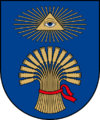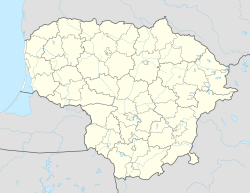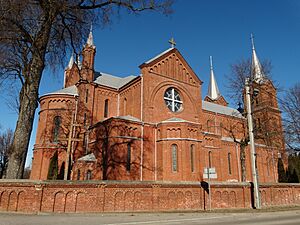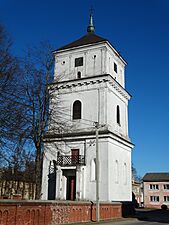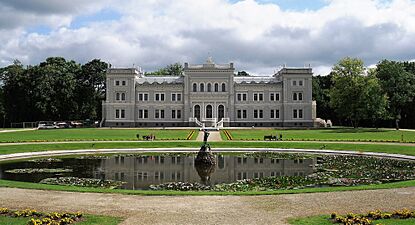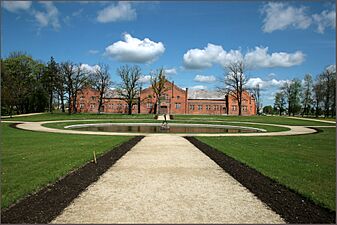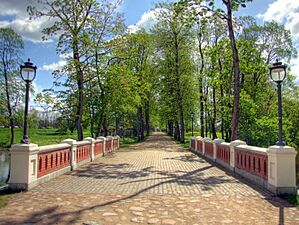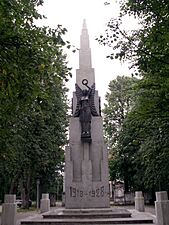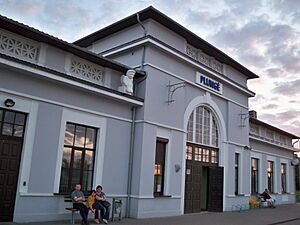Plungė facts for kids
Quick facts for kids
Plungė
|
|||
|---|---|---|---|
|
City
|
|||
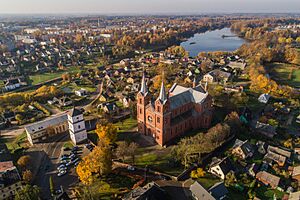
Aerial view of Plungė
|
|||
|
|||
| Country | |||
| Ethnographic region | Samogitia | ||
| County | Telšiai County | ||
| Municipality | Plungė district municipality | ||
| Eldership | Plungė town eldership | ||
| Capital of | Plungė district municipality Plungė town eldership Plungė rural eldership |
||
| First mentioned | 1567 | ||
| Granted city rights | 1792 | ||
| Population
(2022)
|
|||
| • Total | 17,252 | ||
| Time zone | UTC+2 (EET) | ||
| • Summer (DST) | UTC+3 (EEST) | ||
Plungė () is a city in Lithuania with about 17,252 people living there. It is famous for the beautiful Plungė Manor and its large park. Inside the manor, you can find the Samogitian Art Museum. In the park, there's also a very old and special tree called the Perkūnas Oak, which is a natural monument.
Plungė also has a special place called the Lourdes of Plungė, built in 1905, which many visitors like to see. In the city center, there's a monument celebrating 10 years of Lithuania's independence. You can also see a sculpture of Saint Florian, made by a famous Lithuanian book carrier named Kazys Barzdys. The city is also home to a factory that makes crab sticks, which are sent to many countries in Europe!
Contents
A Look at Plungė's Past
It is believed that people lived in the area where Plungė is now located a very long time ago, even before the time of Christ. Around the 14th to 16th centuries, Plungė was a small settlement within the Gandinga district. Over time, Plungė grew much faster than Gandinga.
In 1567, Plungė was first officially mentioned as a town. It was part of the Duchy of Samogitia, which was a region within the large Grand Duchy of Lithuania and later the Polish–Lithuanian Commonwealth.
On January 13, 1792, Plungė was given special Magdeburg rights. These rights allowed the town to govern itself more freely. From 1806 to 1873, Plungė belonged to a person named Platon Zubov. After that, it became the property of the Ogiński family. They built a grand palace there in 1879.
Between World War I and World War II, Plungė continued to develop. A high school (gymnasium) was opened in 1925. A railway line was built in 1932, making travel and trade easier. In 1933, the main Catholic Church was officially opened. A private hospital started in 1939, offering maternity and surgery services. Before World War II, many Jewish people lived in Plungė and were an important part of the town's life. They made up about half of the population.
During World War II, Plungė faced very difficult times. In June 1941, German forces took control of the city. Sadly, during this period, many Jewish residents of Plungė were killed. There are special places in and around the town today that remember these tragic events of 1941. One of the few Jewish people from Plungė who survived the war was Jacob Bunka, who later became a famous sculptor.
Before the Soviet occupation, Plungė's economy was strong. It had a factory that processed flax and cotton. Jewish business people and local farmers also played a big role in the economy.
After World War II, when Lithuania was under Soviet rule, Plungė grew quickly. Its population increased from 7,400 people in 1950 to about 23,300 by 1990. During this time, Lithuanians became the main group of people living in the city. The Soviet government had big plans for Plungė to become a major industrial center. However, these plans didn't fully happen because the city didn't have enough water. Still, some companies were started there. Many of these companies struggled after Lithuania became independent again.
On June 6, 1997, the official coat of arms of Plungė was approved. In 2009, Plungė was chosen as the Lithuanian Capital of Culture, which was a big honor. Today, Plungė is the sixteenth largest city in Lithuania.
What's in a Name?
The exact meaning of the name Plungė is not fully known. The most likely idea is that it comes from the name of a river called Paplunga, which used to flow through the city.
The city's name is also known in other languages, like Płungiany in Polish, Plongė in Samogitian, and Plungyan in Yiddish.
Places to See in Plungė
Plungė has many interesting places to visit:
- Plungė Manor: A beautiful old palace.
- Plungė District Municipal Public Library: A place for books and learning.
- Plungė park: A large and lovely park surrounding the manor.
- St. John the Baptist Church: A historic church in the city.
- St. Florian's sculpture: A unique sculpture in the city center.
- Plokštinė missile base (Cold War Museum): Located near the city, this museum shows a secret missile base from the Cold War era.
Gallery
Getting Around Plungė
Several main roads pass near Plungė, making it easy to reach:
- Highway A11 connects Šiauliai and Palanga.
- Highway 164 goes from Mažeikiai through Plungė to Tauragė.
- Highway 166 links Plungė to Vėžaičiai.
Plungė also has its own railway station. Trains traveling between Vilnius and Klaipėda, and between Radviliškis and Klaipėda, stop here.
Sports in Plungė
Plungė is home to a few sports teams:
- Football: The football club "FK Babrungas Plungė" plays in the Western Zone of the Lithuanian Football Federation's 2nd League. They play their games at the Central Stadium of Plungė.
- Basketball: The basketball club "Olimpas Plungė" plays in the National Basketball League. The team was started in 1989. In 1997, BC Olimpas even reached the finals of the Lithuanian Basketball League, but they lost to BC Žalgiris Kaunas. After some time away from national competitions, the team returned in 2011. They won gold medals in the Regional Basketball League in 2012 and moved up to the National Basketball League. Their home games are played at the "SS Žemaitijos Suvenyras" arena, which can hold 200 people.
Plungė's Sister Cities
Plungė has special friendships with other cities around the world. These are called "twin towns" or "sister cities":
 Bjerkreim, Norway
Bjerkreim, Norway Boxholm, Sweden
Boxholm, Sweden Bruntál, Czech Republic
Bruntál, Czech Republic Golub-Dobrzyń, Poland
Golub-Dobrzyń, Poland Konotop, Ukraine
Konotop, Ukraine Kvareli, Georgia
Kvareli, Georgia Menden, Germany
Menden, Germany Tukums, Latvia
Tukums, Latvia Viljandi County, Estonia
Viljandi County, Estonia
Famous People from Plungė
Many notable people have connections to Plungė:
- Chaim Yitzchak Bloch Hacohen: A religious scholar.
- Jacob Bunka: A folk artist known for creating Holocaust memorials.
- M. K. Čiurlionis (1875–1911): A famous Lithuanian composer and artist who lived in Plungė.
- Lazarus Goldschmidt (1871–1950): A translator of the Talmud.
- Zenonas Ivinskis (1908–1971): A historian born in Plungė.
- Jurgita Jurkutė (1985): Miss Lithuania 2007, born in Plungė.
- Bronislovas Lubys (1938–2011): An entrepreneur and former Prime Minister of Lithuania.
- Renatas Norkus: A former Lithuanian ambassador to the United Kingdom.
- Wanda Rutkiewicz (1943–1992): A famous mountaineer, the first European woman to climb Mount Everest and the first woman to reach K2.
- Aistė Smilgevičiūtė (1977): A singer born in Plungė.
- Petras Vyšniauskas: A jazz saxophonist who was born and grew up there.
See also
 In Spanish: Plungė para niños
In Spanish: Plungė para niños



